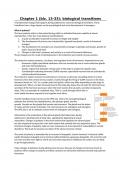Summary
Samenvatting exam 1 - adolescent development
- Course
- Institution
- Book
Summary of: - chapter 1 (13-33) - chapter 2 - chapter 3 - chapter 8 - chapter 9 (244-261) - chapter 13 - Balloonoff (2017) - Coe-Odess (2019) - Degenhardt (2016) - Orbs (2020) & lecture notes (1 to 7)! In short, everything you need to learn for exam 1 of adolescent development;)
[Show more]



